Community Board says no to the White Street jail proposal
Community Board 1 gave a no vote – with conditions – to the jail proposed for White Street at a meeting of its land use committee this week. The meeting – which I watched from the comfort of my own couch, with a Diet Coke drip, thanks to a Facebook Live broadcast provided by the borough president’s tech-savvy office – was not nearly as raucous as the previous ones, but it still showed how this issue has polarized the city. On one side of the issue are local residents girding their loins and then some for the nightmare prospect of a 450-foot building built by government in their neighborhood. On the other are advocates for closing Rikers and improving conditions for, well, residents of the jail itself. (Thanks to Alice Blank for sending the photos from the environmental impact statement.)
The city’s proposal has already morphed from the last meeting, and board members pushed hard to get it withdrawn in order to force the city to rethink the entire plan. But that idea was a no go: “The time for the city on this four-borough jail system is now,” said a rep for the administration.
To sum up: The city is saying the plan is “flexible” – as in a good thing. The community board is saying it’s half-baked. “We are dealing with the mayor’s timetable rather than a project that the community will deal with for the next 100 years,” said Michael Kramer.
Some new, or at least uncovered, details since the last meeting:
- The city is now saying they need 1,150 beds at this site, down from 1,400 – but the building is not getting smaller in their presentation
- This building is 466,000 square feet BIGGER than the as-of-right build on those two lots – with no significant community give-back (that I can see at least – they keep talking about retail as a community bonus, but a Duane Reade inside a jail doesn’t sound like a primo retail destination to me)
- White Street will be taken off the city grid; it will be a pedestrian street only with a building over it (Streets get demapped for pedestrian use, but this does not at first glance look that appealing, “It’s no longer a street, it’s a tunnel,” said Alice Blank.)
Conditions and points from Board 1 on this reso (will be voted on at the full board meeting on May 28):
- A minimum of 30 percent height reduction
- Make Staten Island build a jail too, to further reduce the beds in the other four boroughs (This totally makes sense. Sure, they are smaller, but every bit counts.)
- Taking down buildings like this is hardly environmental – ie mayor’s Green New Deal support. (This makes me wild — the idea of throwing out buildings of that size. Not clear why the city cannot reconsider adaptive reuse of the existing buildings, one of which is eligible for landmarking – for example, how many people *could* those buildings accommodate?)
- Show plan for the senior center next door
- Fully explain the impact of the design/build plan
One more succinct summary from board member Laura Starr: “We support justice reform – but we need a real look at what’s needed and not ‘let’s not build a giant bucket and figure it out from there.’”







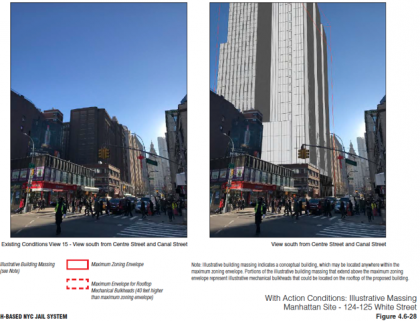
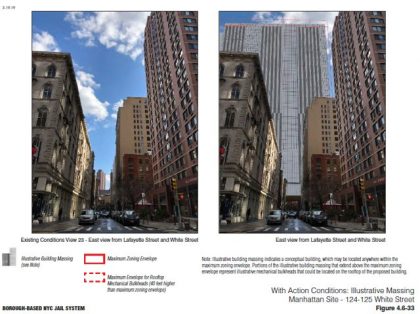
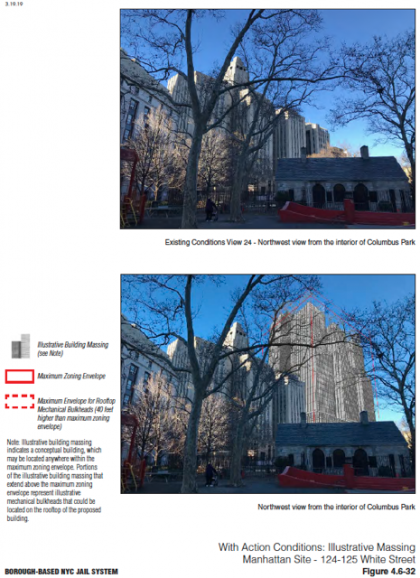
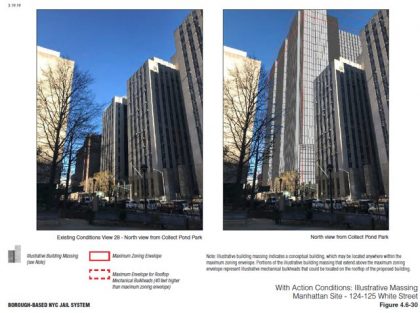
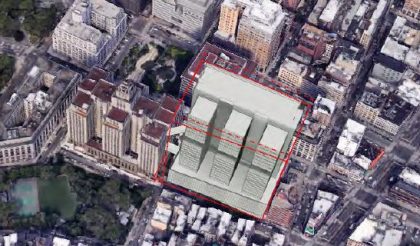
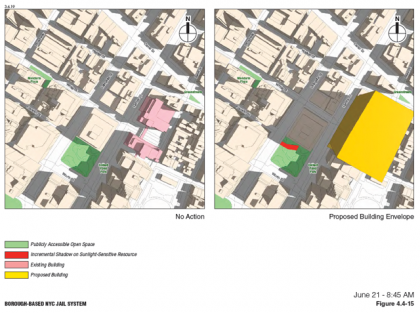






Excellent report. Glad CB1 is holding firm against this plan.
However, I think the concerns go deeper. At least I have still not found a good answer to the question:
If the goal is criminal justice system (including jail system) reform, why can’t all that be done at the existing Rikers location?
That would be a solution where everyone “wins” (as much as anyone can win in such an unhappy topic).
I just don’t see why the goal of reforming the justice and jail systems has anything to do with changing the location. The move seems to be totally separate unrelated project, which will cost the city billions, not to mention all these other neighborhood/community concerns. So what’s the real motive for this move?
This is me being a messenger, not an advocate of the move. The plan is two-fold: 1) to make the jails more accessible for families to visit and advocate, and for defendants to get to their court dates easier, by siting them in a less remote location and 2) to rebuild the physical plant to make it more open and rehabilitative — in the progressive notion of jail reform. From a system-wide approach, getting people on and off Rikers was time consuming and costly. I think it is also safe to say that after the imprisonment, abuse and death of Kalief Browder, the connection between his experience and the actual physical place — Rikers — pushed the issue along.
Thank you for the thoughtful comment. Regarding point 1, that seems reasonable, although a less remote location does not necessarily entail putting it in the middle of this particular community. It could be a less populated area. Another consideration would be that, wherever the jail is located, at least some of the courts are moved close to there as well. Not sure if that idea is possible; has it been considered? Maybe it’s important for the courts to be close to other city offices, which would make that untenable.
As for point 2: It’s unfortunately still debatable what effects the move will have on jail reform. Some argue that the corruption and violence problems will just be moved, not mitigated. For example,
“Mark Peters, the commissioner of the New York City Department of Investigation, which has been investigating conditions at Rikers Island, is concerned that relocating inmates and jail personnel to smaller facilities across the city could simply spread the problems around instead of solving them.”
https://www.cityandstateny.com/articles/politics/new-york-city/closing-rikers-won’t-solve-underlying-problems,-doi-commissioner-says.html
I (and surely others) are also concerned about how the goal of reducing jail and prison populations, and therefore supposedly reduction in crime, will be achieved. If those are real reductions in bad behavior — i.e. people are actually behaving better towards one another — along with real justice system reform, then this is wonderful and laudable. If instead it’s just a game of selective reporting and spinning of statistics, choosing not to enforce certain laws, etc., then there is a concern that crime (from quality of life issues all the way to serious violent crimes) will actually increase, despite the “numbers” saying otherwise (lies, damn lies, statistics). I, for one, am not nostalgic for a return to that kind of “gritty” “authentic” NYC. I grew up in that kind of environment, and have no desire to re-live it.
Interesting idea — moving the courts too. But I think that would mean even more construction. So yes, to point 1, they are trying to get defendants closer to the court, and the Manhattan courts happen to be here with us. I am kind of with you on 2 — that the culture will have to change more than the physical space. The Peters quote nails that. But advocates argue that changing the habitat — adding light, more space, more flexibility — changes the tone and culture too. This is of course a discussion with school buildings as well, but I long ago got over that. I have known amazing schools in sucky physical plants, and vice versa.
I think the main way they are reducing the population of the jail (note jail, not prison, so pre-sentencing) is by bail reform. And I don’t think there are many arguments to be made against that.
Yes, the moving of courts idea was just off-the-cuff, although depending where the jail/prison/courts complex is moved, it could end up less expensive than the current plan.
Bail reform sounds promising indeed, but I know little about that.
As for light, space, etc., again that can be achieved at Rikers itself or a different location altogether through renovation or new construction.
Does anyone know: How do other large cities deal with these issues? Surely there are other cities with large prison and jail populations, whereas again the courts are in the center of the city, and the jails and prisons are at a remove from the populated centers. I would hope that the task group considering this problem has studied other cities’ solutions (and failures), both in the USA and in other countries. As with most civic/cultural/sociological/design issues, it’s a fine balance and compromise between competing goals and demands.
NY Post: “De Blasio administration used inaccurate renderings for proposed Bronx jail: study”
“The 25-story lockup eyed for Mott Haven — which is part of Mayor Bill de Blasio’s larger efforts to shutter the scandal-scarred Rikers Island jail complex by 2027 — is portrayed as significantly smaller and less of an eyesore for surrounding neighborhoods in official documents released by City Hall for a mandatory public review process, according to urban planner George M. Janes.”
https://nypost.com/2019/07/05/de-blasio-administration-used-inaccurate-renderings-for-proposed-bronx-jail-study/amp/